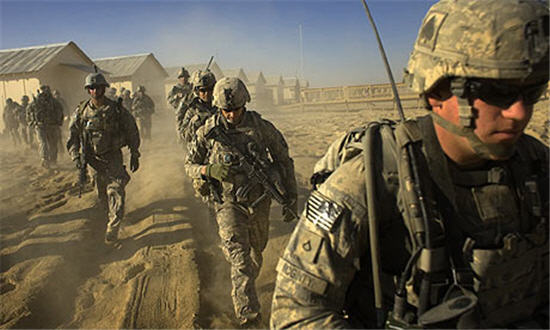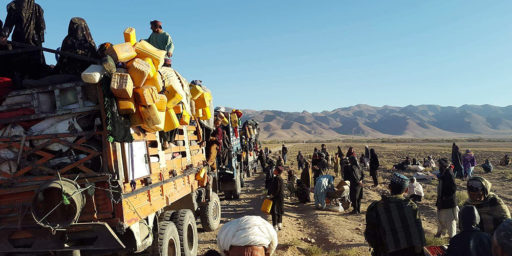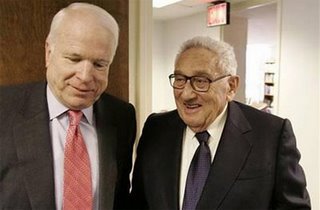Tough Questions on Afghanistan
We need to ask ourselves some tough questions on Afghanistan.
Mark Safranski asks a series of tough questions about Afghanistan. Here are the first four:
Are all the strategic objectives in Afghanistan clearly defined and acheivable by military force?
Of the operational activities that might support our strategic objectives that require civilian expertise, why in nine years have we not sent adequate civilian agency representation and funding?
If military operations in Afghanistan require a single commander, why does the civilian side of the COIN campaign have authority divided between at least a half-dozen senior officials without anyone having a deliverable “final say” reporting to the President?
If Pakistan’s “partnership” is officially a requirement for strategic success (and it is), why would Pakistan be a “partner” in helping stabilize an independent regime in Afghanistan that would terminate Pakistan’s ability to use Afghanistan as “strategic depth”?
And those are the easy ones.
I could add a dozen more but I’ll only add one. Standard counter-insurgency doctrine would call for a force of something like 450,000 troops in Afghanistan. The experience of the last eight years should tell us that Afghanistan will not be able to make up the difference between what NATO is providing and that 450,000 for the foreseeable future. How can this by our own standards inadequate approach to COIN ever be successful?
See also this review of the documentary film Restrepo:
The movie depicts the troops as facing an insurmountable task, trying to conduct a counter-insurgency campaign where they are bottled up in firebases and cannot come out to provide security for the population. The Taliban rule the countryside. The Americans can foray out, and bring down heavy firepower when they encounter the Taliban, but the fundamental mismatch between what the troops have been asked to do and the means provided to do it is apparent throughout.







And, of course, it will simply be politically impossible for the United States to commit more troops to Afghanistan than we’ve committed at any time since the Gulf War.
Someone needs to send these questions to the people in charge in Washington and demand answers.
Troop ratios are debatable concepts in COIN. Here is a link to an analsysis of the evidence and concludes that a ratio of 11 forces per 1,000 population was appropriate in Afghanistan 2009. That would be around 309,650 troops. (I’m currently counting 363,000 troops, of which 243,000 are Afghan and 120,000 are NATO)
Under this formulation, if the level of violence goes down, the troop strength need is decreased, and increased if the violence goes up. And the more Afghans are among the troops, the ratio is decreased as well.
The Army Field Manual says 20 forces per 1,000, which I calculate as a requirement of 563,000 troops, but as this link suggests, that number appears to simply be based upon observations of the ratio of British troops in Northern Ireland and Malay.
http://www.thefreelibrary.com/A+historical+basis+for+force+requirements+in+counterinsurgency.-a0222315606
Where are you getting your numbers on the size of the Afghan military, PD? According to both Wikipedia and Global Security the number is less than half that. The only way I can see that number is by including militias. I’m not sure whether to count Afghan militias as adding to Afghanistan’s security forces or to the enemy’s.
Then there’s the subject of readiness. Maybe you’ve seen different but I’ve read little but scathing characterizations of Afghan forces’ military readiness.
PD,
Even if you are correct, the strategy does require a level of trust in both the competence and honesty of Afghan forces that may not be warranted.
“I could add a dozen more but I’ll only add one. Standard counter-insurgency doctrine would call for a force of something like 450,000 troops in Afghanistan.”
Actually it calls for considerably more. The partially Petraeus authored armyusmc counterinsurgency manual which I purchased from Amazon about 2 years ago calls for a ratio of 20 troops to every 1000 of population (ie 50:1). Now there is some debate about the size of the Afghan population but most put it at between 30 and 33 million so on this basis the force requirement is 600,000 to 660,000. Now given that the Afghan army is 90 illiterate, largely corrupt, heavily infiltrated by the Taliban, and owes its principal loyalty to tribe or local warlord it’s obviously at best only providing a fraction of this force. Now the other thing the manual talks a lot about is force density on the ground. Afghanistan is roughly 250,000 sq miles compared with the 67,000 sqm of south Vietnam. The peak force we had in Vietnam was around 550,000 giving a density of over 8 per square whereas the current force we have there of around 100,000 gives a density of about 0.36 in a landlocked country with an average height of 5000 feet above sea level. And of course we lost in Vietnam. This is theoretically not a task beyond us but it would require a level of committment in forces and expenditure that the US is not willing to make ergo defeat or indefinite costly stalemate is inevitable.
Even if we could theoretically put enough men into Afghanistan we wouldn’t want to expose them to a situation where supply lines could be easily cut off by countries whose goodwill cannot be relied upon.
“but as this link suggests, that number appears to simply be based upon observations of the ratio of British troops in Northern Ireland and Malay.”
What this link suggests is irrelevant since the armyusmc manual is an official US publication and not the observations of some self appointed “experts.”. And the comparisons with Northern Ireland and Malaya are completely specious. Two thirds of the population of Ulster are fervently loyal to Britain so to the extent a counterinsurgency campaign was being fought in N. Ireland (which is highly debatable) it was being fought amongst a predominantly friendly population. In Malaya the same was broadly true in that the great majority of Malays were loyal and Gerald Templer made them a key part of his campaign. In Afghanistan the absolute opposite is true. I’ve little doubt at least half the population are sympathetic to the Taliban and deeply xenophobic.
Dave, I’m using military and police forces combined:
http://www.cbc.ca/world/story/2010/06/10/nato-chief010.html#ixzz0svxmUOov
I think if you were really going to do this, you would probably have to go province by province. Up in some Northern sections, you might just need 2.2 security forces per 1,000, which is what the Allies had in post-war Germany. So, if there are a bunch of NATO security forces in that area, it’s not helping secure the Kandahar region, where a higher ratio would be needed.
From my earlier link: “in counterinsurgency, the higher the proportion of local security forces the better. This may seem counterintuitive, since local forces may not be trained, led, or equipped to western standards. Local forces possess distinct advantages, however, in terms of native familiarity and increased commitment.”
Here is what the Field Manual says about troop strength:
“[N]o predetermined, fixed ratio of friendly troops to enemy combatants ensures success in [counterinsurgency]…. A better force requirement gauge is troop density, the ratio of security forces (including the host nation’s military and police forces as well as foreign counterinsurgents) to inhabitants. Most density recommendations fall within a range of 20 to 25 counterinsurgents for every 1,000 residents in an [area of operations]. Twenty counterinsurgents per 1,000 residents is often considered the minimum troop density required for effective [counterinsurgency] operations; however, as with any fixed ratio, such calculations remain very dependent on the situation.”
It’s not a rule, and it ain’t science.
PD Shaw says:
“Twenty counterinsurgents per 1,000 residents is often considered the minimum troop density required for effective [counterinsurgency] operations; however, as with any fixed ratio, such calculations remain very dependent on the situation.”
It’s not a rule, and it ain’t science.”
Of course it’s not science but it’s a rough guide and the situation is about as horrible as they come given we’re talking about a mountainous country of around 30 million people most of whom are tribally organized, western hating farm boys who have guns and know how to use them, and the indigenous govt and forces are a total basket case. If this isn’t the definition of the “worst” scenario requiring maximum troop densities I don’t WTF is. Even Arvin weren’t remotely as screwed up as these guys and that’s saying something.
. “Up in some Northern sections, you might just need 2.2 security forces per 1,000, which is what the Allies had in post-war Germany.”
Postwar Germany and Afghanistan? You can’t be serious.
I hope that one thing we are learning is that not all counterinsurgencies are the same. That troop ratio is very fluid. Insurgents are likely to concentrate in some areas and avoid others. Rather than concentrate on the absolute number, I dont think northern and western Afghanistan have ben that active, I would be more worried about the quality of the troops and the Afghan government.
Safranski’s questions are good ones. My one question would have been something about how we expect to ever achieve a legitimate Afghan government and can we succeed w/o one?
Steve